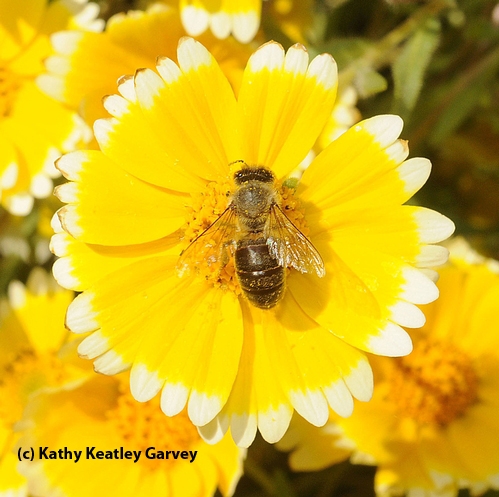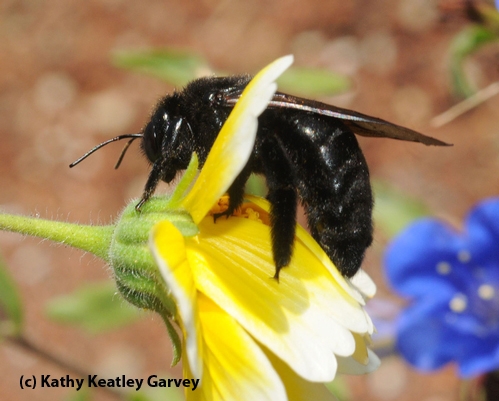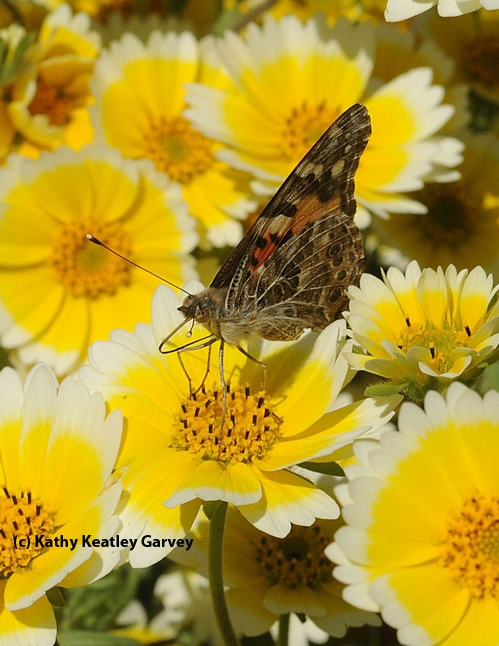- Author: Kathy Keatley Garvey

When you attend the UC Davis Biodiversity Museum Day on Saturday, Feb. 15, you'll see these California natives blooming in the Biological Orchard and Gardens (BOG), a 24,000-square-foot treasure behind the UC Davis Botanical Conservatory off Kleiber Hall Drive.
The ninth annual Biodiversity Museum Day, a science-based day that's free and family friendly, will take place from 9 a.m. to 4 p.m. and showcase 13 museums or collections, including the Botanical Conservatory, managed by curator Ernesto Sandoval.
BOG is a living museum, planted not only with several dozen species of heritage fruit trees, but landscaped with colorful mini-gardens.
Among the flowers blooming in the BOG in the early spring, by color:
- Red: European red flax, Linum grandiflorum rubrum, an annual that's native to Algeria
- Yellow: tidy tips, Layia platyglossa, an annual that's native to California
--The seep monkey flower, Mimulus guttatus, native to California
--Lupine, Lupinus, native to North America. - Blue: Desert bell, Phacelia campanularia, an annual herb that is native to California and endemic (limited) to California.
- Lavender: Phacelia, also called Lacy phacelia, blue tansy or purple tansy (Phacelia tanacetifolia), native to the southwestern United States
--Lupine: Lupinus, native to North America - Red-Orange-Yellow: Blanket flower or Gaillardia (Gaillardia × grandiflora), native to North and South America
- Orange: California golden poppies, Eschscholtzia californica
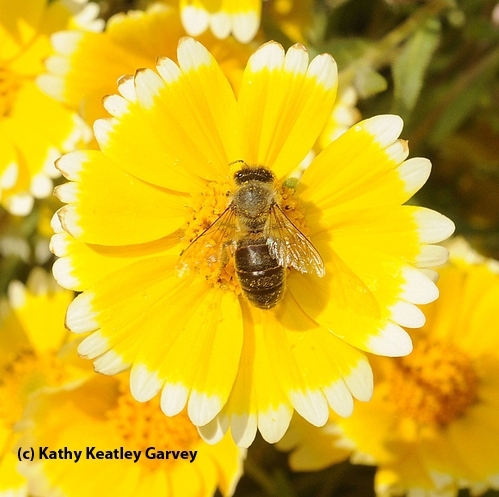
The orchard contains heritage fruit tree varieties threatened with commercial extinction. They include the Gravenstein and Johnathan apples; the Suncrest peach; the Bleinheim apricot, the Mariposa plum and the Meyer lemon. See the full list of trees as well as some fun facts here: https://thebogatucd.wixsite.com/bogucd/single-post/2017/07/18/BOG-Fruit-Trees.
UC Davis Biodiversity Museum Day
The ninth annual UC Davis Biodiversity Museum Day is billed as a “free, educational event for the community where visitors get to meet and talk with UC Davis scientists from undergraduate students to staff to emeritus professors and see amazing objects and organisms from the world around us,” according to Biodiversity Museum Day coordinator Tabatha Yang, education and outreach coordinator for the Bohart Museum of Entomology. Last year's event drew more than 4000 visitors. The event is always held the Saturday of Presidents' Day weekend.
The schedule is online at http://biodiversitymuseumday.ucdavis.edu/schedule.html.
Participating museums or collections and the hours they will be open:
- The Botanical Conservatory, the Greenhouses along Kleiber Hall Drive, will be open from 9 a.m. to 4 p.m.
The following five will be open from 9 a.m. to 1 p.m.:
- Arboretum and Public Garden, Shields Oak Grove, alongside the Vet School, Garrod Drive on campus
- Bohart Museum of Entomology, Room 1124 and Main Hall of the Academic Surge Building, Crocker Lane
- California Raptor Center, 340 Equine Lane, off Old Davis Road
- Museum of Wildlife and Fish Biology, Room 1394 and Mail Hall, Academic Surge Building, Crocker Lane
- Paleontology Collection, Earth and Physical Sciences Building, 434 LaRue Road
Two collections will be open from 10 a.m. to 2 p.m.:
- Phaff Yeast Culture Collection, Robert Mondavi Institute of Wine and Food Science, 392 Old Davis Road, on campus
- Viticulture and Enology Culture Collection, Robert Mondavi Institute of Wine and Food Science, 392 Old Davis Road, on campus
These five will be open from noon to 4 p.m.:
- Anthropology Museum, 328 Young Hall and grounds
- Center for Plant Diversity, Sciences Laboratory Building, off Kleiber Hall Drive
- Häagen-Dazs Honey Bee Haven, Bee Biology Road, off Hopkins Road (take West Hutchison Drive to Hopkins)
- Nematode Collection, Sciences Laboratory Building, off Kleiber Hall Drive
- Marine Invertebrate Collection, Sciences Laboratory Building, off Kleiber Hall Drive
All 13 sites are within walking distance except for the Häagen-Dazs Honey Bee Haven on Bee Biology Road and the Raptor Center on Old Davis Road. Further information, including a campus map, is available on the UC Davis Biodiversity Museum Day website. Maps will be distributed at the 13 sites.
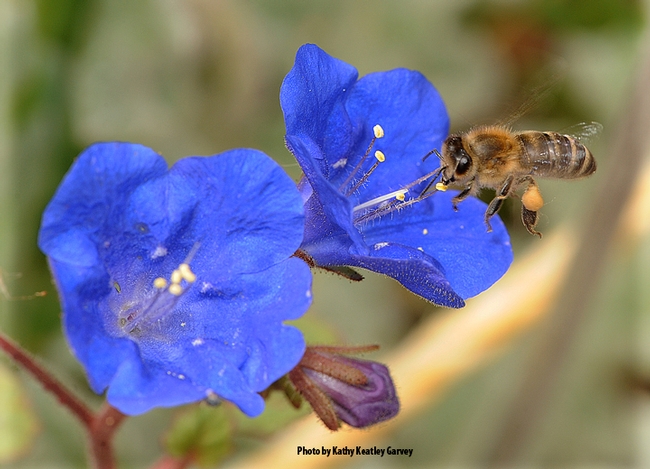

- Author: Kathy Keatley Garvey
In between the rains today, we saw them.
So beautiful! Painted ladies, Vanessa cardui, nectaring in patches of colorful wildflowers in the Biological Orchard and Gardens (BOG), located behind the Mann Laboratory on University of California, Davis campus.
The migratory butterflies, passing through California on their way to the Pacific Northwest, stopped there for some flight fuel: sipping nectar from tidy tips, Layia platyglossa; five-spot, Nemophila maculate, and blue lupine, Lupinus.
They've been in the national news a lot, these butterflies, as has butterfly guru Art Shapiro, UC Davis distinguished professor of evolution and ecology. Known for his expertise on all things butterfly, he's monitored the butterfly population of Central California since 1972 and maintains a research website.
Yes, it's been a big year for painted ladies, thanks to the heavy rainfall and super blooms in the deserts near the Mexican border. And, as Shapiro says, tremendous wildflower blooms are typically great years for the painted ladies.
New York Times reporter Julia Jacobs interviewed Shapiro for her March 17th piece, in which she marveled that millions of the painted ladies are migrating. Shapiro told her: "The striking thing is they're moving very rapidly and directionallly. So it's almost like being in a hail of bullets.”
Rita LeRoy or "Farmer Rita," the self-described "Farm Keeper" on the Loma Vista Farm, Vallejo, part of the Vallejo City Unified School District, saw the butterflies passing through the farm on Monday, March 17. Her description is fabulous:
"They came through Vallejo on Monday," she said. "Art's description was right on. It was like being in a hail of bullets. This was because they were flying so low and it was a constant stream, like standing in the middle of a 500 lane expressway. I kept telling the students, 'Look! Another, another, another...' The path was at least as wide as the farm which is about 200 yards. When I stood in one spot, I would agree they were passing within my vision (about 100') at about 1 every second. They rarely stopped to nectar but were flying in a very direct NE direction when they came through the farm. They flew through nonstop from before 1 p.m. and the flow started to dwindle around 4 p.m. Still enough at that point to show the after school kids. They didn't fly in huddled groups or clouds and they moved fast. I tried taking a video but it was like a bad remake of The Blair Witch Project, with unfocused, whiplash camera moves of uncertain objects since they are so small in the overall background. I'm so glad Art saw them."
Today (Wednesday) we didn't see the hail of bullets, but we did see about a dozen of them grabbing some flight fuel on the UC Davis campus over a 10-minute period.
If you get a chance, check out the Biological Orchard and Gardens. A 24,000-square-foot garden, located behind the Mann lab, off Kleiber Hall Drive, it's planted with several dozen species of heritage fruit trees, and landscaped with flower gardens. The painted ladies are elsewhere on campus, too, including the UC Davis Arboretum and Public Garden.
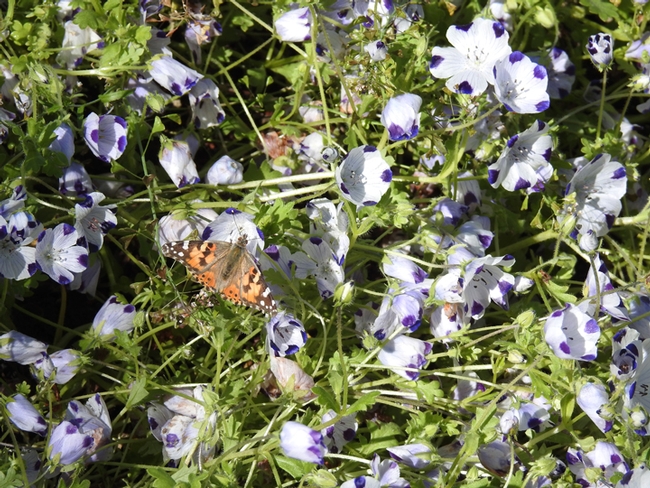
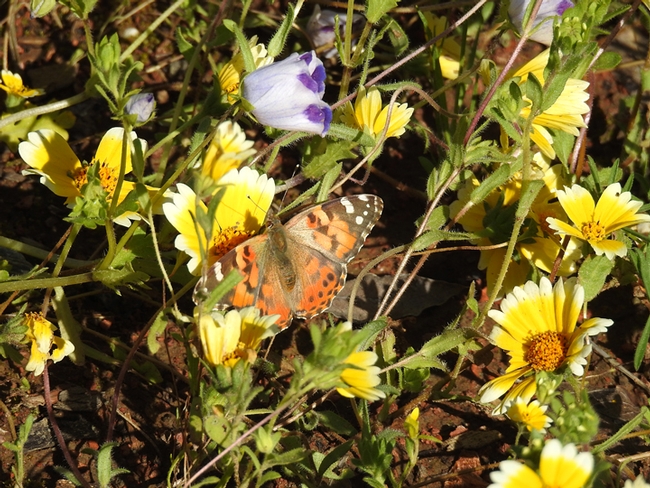

- Author: Kathy Keatley Garvey
If you see a patch of California native wildflowers known as "Tidy Tips," look closely.
The yellow daisylike flower with white petals (Layia platyglossa) may yield a surprise visitor.
You may see an assassin.
An assassin bug.
A member of the family Reduviidae, this is a long-legged, beady-eyed beneficial insect that stalks its prey and snatches it with its forelegs, somewhat like a praying mantis. It conquers its victim with a squirt of deadly venom from its beak (the collective term for its piercing, sucking mouthparts).
Once it has immobilized its prey, the assassin sucks the bodily contents, like a milkshake slurped through a straw.
The critter below is a assassin bug from the genus, Zelus, according to Lynn Kimsey, director of the Bohart Museum of Entomology and professor and vice chair of the UC Davis Department of Entomology.
The name, Zelus, originates from Greco-Roman mythology. Zelus, a winged enforcer, guarded the throne of Zeus.The assassin bug, true to its name, ambushes, attacks and captures other insects, such as aphids, flies, crickets, mosquitoes, beetles, caterpillars and "sometimes a hapless bee," said Bohart senior museum scientist Steve Heydon.
One thing about the Zelus assassin bug--it does not fly very fast. In fact, it totally ignored the camera poked close to its protruding eyes.The camera neither looked like or acted like a predator or prey.
No worries.

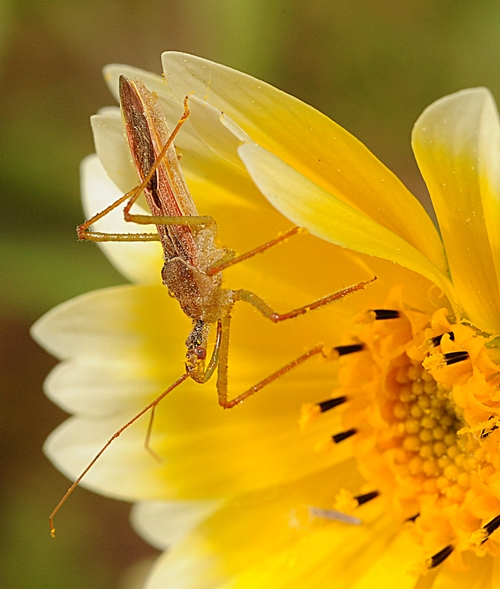
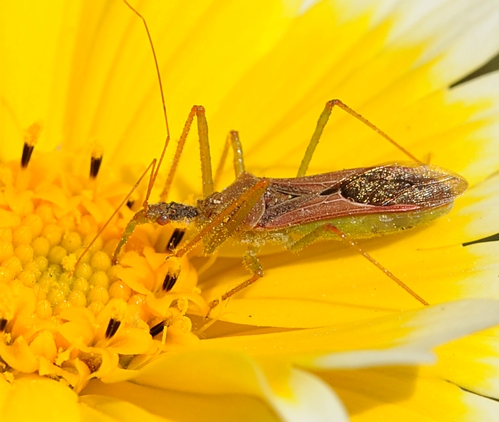
- Author: Kathy Keatley Garvey
The Tidy Tips, a native California wildflower (Layia platyglossa, family Asteraceae) is a welcome addition to flower beds.
If you walk behind the Sciences Laboratory Building on the University of California, Davis, campus, patches of Tidy Tips abound.
If it's cold, windy and rainy, no honey bees. If we're graced with a "sun break," here come the bees.
Sun break on the Tidy Tips...a sure sign of spring.
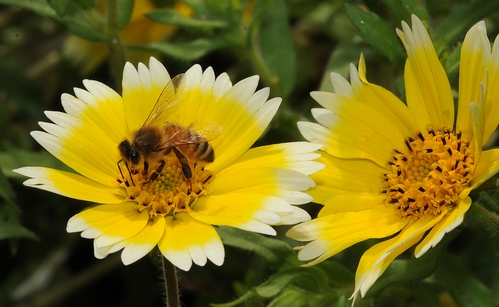
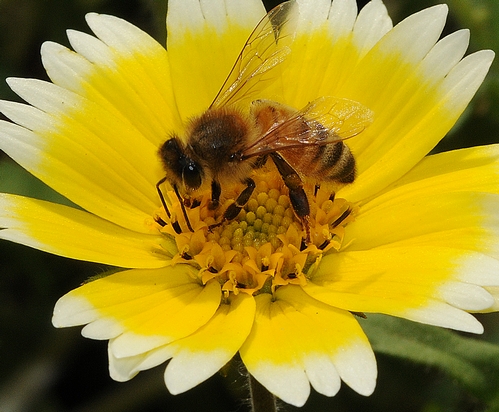
- Author: Kathy Keatley Garvey
It's not spring until you see honey bees, carpenter bees and butterflies on Tidy Tips.
That would be Layia platyglossa, a wildflower native to southern California. Its common name is "Tidy Tips" or "Coastal Tidy Tips." It's a daisylike flower with yellow petals tipped in white, thus the name. It's a member of the aster family.
A flower bed in the center of the UC Davis campus (near the Science LaboratoriesBuilding) boasts an intermingling of the yellow-and-white Tidy Tips and sky-blue Desert Blue Bells (Phacelia campanularia).
Gorgeous!
Insects think so, too. On any given day you'll see honey bees, carpenter bees, butterflies and lacewings holding family reunions.
